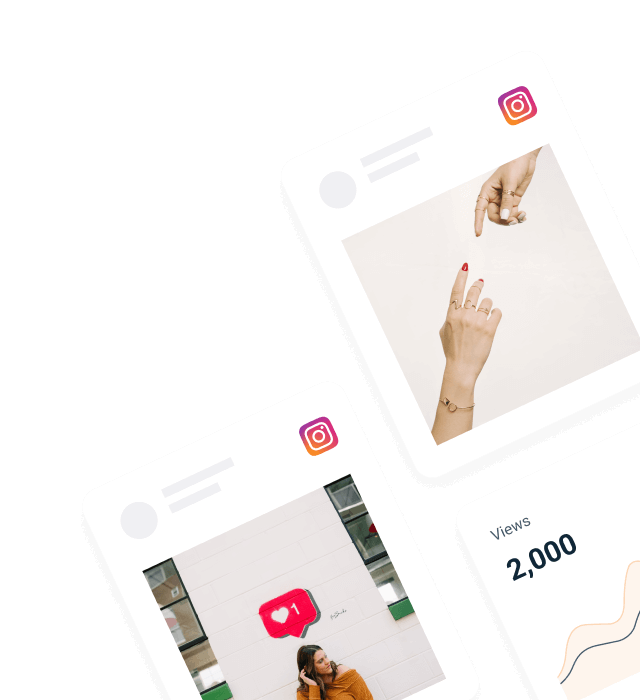Are you looking for a way to keep users engaged inside your SaaS platform without building complex social features from scratch? A custom social display might be exactly what your product needs.
SaaS platforms can oftentimes struggle with user retention after the initial onboarding phase. Users sign up, explore the core features, then gradually drift away.
But what smart product teams have figured out: embed social media feeds, and you create a sense of community and ongoing activity that keeps users coming back, helping to increase engagement and sales.
The ability to display social media feeds transforms any SaaS platform into a dynamic, community-driven experience. Whether you’re building for small business users or enterprise teams, integrating user-generated content directly into your product interface creates authentic touchpoints that traditional features can’t match.
Let’s walk through exactly how to implement and customize social media feed widgets that feel native to your SaaS environment—and actually drive engagement.
Why Embedded Social Feeds Work in SaaS Platforms
Social widget customization isn’t just about aesthetics. When done right, it transforms static product interfaces into dynamic, community-driven experiences that boost social media engagement.
Think about it: your users aren’t just using your tool in isolation. They’re talking about it on LinkedIn, sharing wins on Twitter feed, posting tutorials on Instagram, reviewing on Google reviews, and creating YouTube videos. That conversation is happening across different platforms, whether you surface it or not.
“The best SaaS platforms make users feel part of something bigger.”
An embedded social feed captures that energy and brings it directly into your product experience. Users see real people getting real results, which reinforces their decision to stick with your platform. A well-implemented social wall can display social media feeds that showcase authentic customer feedback and success stories.
Here’s what changes when you add engaging content strategically:
Increased session duration. Users spend more time exploring fresh content, especially testimonials and use case examples from other customers displayed through social media feed widgets.
Higher feature adoption. Seeing other users showcase different features through user-generated content naturally leads to exploration and experimentation.
Improved onboarding completion. New users see proof that others are succeeding through latest social posts, which reduces abandonment during setup phases.
Enhanced social proof. Real customer content from social media networks beats static testimonials every time, helping visitors engaged with your platform stay longer.
Customization Options That Actually Matter
Your social widgets need to feel like they belong in your product, not like an afterthought. Here’s where customization becomes crucial for any web designer or product team looking to easily embed social content.
Design integration should provide seamless integration with your existing interface. The widget’s colors, fonts, and spacing should match your SaaS platform perfectly. Most social media aggregator tools offer CSS customization, but the key is knowing which elements to adjust to make content seamlessly blend with your product design.
Focus on these design elements first:
- Typography consistency. Match your product’s font family and sizing hierarchy. Nothing screams “third-party widget” like mismatched text in your social wall widget.
- Color harmony. Align the widget’s background, text, and accent colors with your brand palette. Even small color discrepancies feel jarring in a polished SaaS interface where you want to display social media feeds naturally.
- Layout responsiveness. Your social feed widget needs to work across desktop dashboards, mobile apps, and tablet interfaces without breaking your existing layouts.
Content filtering matters more than design. You’ll want to curate which social media posts appear based on relevance, not just recency. Look for tools that let you moderate posts effectively, offering hashtag filtering, keyword moderation, and manual approval queues. The ability to filter by specific hashtags ensures you only show content that aligns with your brand values.
The goal isn’t to show every mention of your brand—it’s to show the content that reinforces your product’s value proposition and helps increase engagement with your SaaS platform.
Implementing Custom Social Displays with Juicer
Juicer makes feed embedding straightforward for SaaS teams who want control without complexity. Whether you’re starting with a free plan or need advanced features from paid plans, the platform lets you easily create professional social media feed widgets.
Multi-platform aggregation lets you pull content from multiple social media platforms into a single feed. Instead of managing separate Instagram feed widgets, Twitter feed streams, Facebook page content, and LinkedIn posts, you get one unified dynamic feed that updates automatically across all social channels.

Here’s the implementation process to embed social media feeds effectively:
1. Set up your content sources. Connect the social media accounts and hashtags that generate relevant customer content. You can mix branded hashtags with general industry terms to capture both direct mentions and broader conversations across social platforms. This works whether your site shows content from Facebook, Instagram, or other social media networks.

2. Configure content moderation. Use Juicer’s approval queues to review posts before they appear in your social widget. This prevents off-brand content from appearing in your product interface and ensures only quality user-generated content reaches your users.
3. Customize the display. Adjust the feed layout, colors, and sizing to match your SaaS platform’s design system. Juicer’s custom CSS options give you control over spacing, typography, and visual hierarchy, ensuring seamless integration with your existing interface.
4. Embed with minimal code. Add the embed code to your dashboard, community section, or onboarding flow. The social feed updates automatically without requiring ongoing development resources, and you get great support throughout the implementation process.
“The best social widgets feel invisible—users engage with the content, not the technology.”
Strategic placement makes the difference between a helpful feature and digital clutter. Consider these high-impact locations:
Dashboard sidebar for ongoing engagement during regular platform use.
Community or help sections where users are already seeking inspiration and guidance.
Onboarding flows to show new users that others are actively succeeding with your product.
Feature announcement pages to demonstrate real-world adoption of new capabilities.
WordPress and Website Integration for SaaS Companies
Many SaaS companies run their marketing sites on WordPress site infrastructure while hosting their actual product on different platforms. If you’re managing both a WordPress website and your SaaS application, you can create consistent social media engagement across both environments.
Website owners often struggle to maintain fresh content on their marketing pages. By implementing social media feed widgets on both your WordPress site and within your SaaS product, you create a unified experience that drives website traffic between platforms.
The same embedded social media feeds strategy that works in your SaaS dashboard can enhance your marketing site. Consider adding Instagram feed widgets to case study pages, customer feedback displays on pricing pages, or a comprehensive social wall on your about page. This approach helps visitors engage across your entire web presence and can significantly increase sales by building trust before prospects even start a trial.
Agency plan customers particularly benefit from this dual approach, as they can showcase client success stories consistently across their marketing site and within their SaaS product interface.
Why WordPress Integration Matters for SaaS Teams
Most SaaS companies run their marketing presence on a WordPress website while hosting their actual product on a different infrastructure. This creates an opportunity to easily embed consistent social media content across both environments for maximum impact.
When you embed social media feeds on your WordPress site, you create a bridge between your marketing presence and product experience. Website visitors see the same engaging content and customer feedback that product users encounter, creating consistency that builds trust throughout the entire customer journey.
A web designer can easily create matching social wall widget implementations across both platforms. Your WordPress website might feature Instagram feed widgets on case study pages, Google reviews in the footer, and a comprehensive social wall showcasing user-generated content from different platforms. Meanwhile, your SaaS product displays latest social posts in dashboard sidebars and community sections.
This dual approach helps increase engagement on your marketing site while driving website traffic to your SaaS platform. When your WordPress site shows the same authentic social media engagement that users experience inside your product, it reinforces the value proposition and helps convert more visitors into trial users.
Website owners who implement this strategy often see improved conversion rates because prospects can see real user activity before they even sign up for a trial. The social media feed widgets act as continuous social proof that updates automatically across both platforms.

Quick Setup Guide for WordPress and SaaS Integration
Setting up social media feed widgets across both your WordPress website and SaaS platform doesn’t require complex technical integration. Here’s how website owners can easily embed social content in both environments:
- Start with a single feed source. Connect your primary social media accounts to create one dynamic feed that pulls from multiple social media platforms. This becomes your source of truth for fresh content across both platforms.
- Configure your WordPress site first. Use plugins or embed code to add social media feed widgets to key pages. Focus on high-traffic areas where visitors engaged with your content can see authentic customer feedback and success stories.
- Match the styling. Ensure your social wall widget design integrates seamlessly with both your WordPress website and SaaS product interface. Consistent visual design helps users recognize the same community across platforms.
- Set up content filtering. Use specific hashtag filtering and content moderation to ensure only relevant, brand-appropriate social media content appears across both platforms. This is particularly important when you display social media feeds on public marketing pages.
The result? Visitors engaged on your WordPress site see the same community activity they’ll experience as product users, while existing customers see their success stories reflected in your marketing presence. This creates a virtuous cycle where happy customers become marketing assets that help increase sales.
Content Strategy for Maximum Impact
The type of content you choose to display social media feeds significantly impacts user engagement within your SaaS platform. Different social platforms generate different types of user generated content, and understanding these nuances helps you create more effective social media feed widgets.
Instagram feed widgets work exceptionally well for visual content like product demos, behind-the-scenes content, and customer success celebrations. The visual nature of Instagram content helps visitors engaged with your platform feel more connected to your brand community.
Twitter feed content excels at showing real-time conversations, quick tips, and industry insights. When you embed social media feeds from Twitter, you’re often capturing timely, relevant discussions that keep your SaaS platform feeling current and connected to industry trends.
Facebook page content tends to be more comprehensive, featuring longer-form posts, event announcements, and detailed customer stories. This type of content works well in community sections of your SaaS platform where users have more time to engage deeply.
YouTube videos embedded through your social wall can showcase product tutorials, customer testimonials, and educational content that helps users get more value from your platform. Video content typically generates higher engagement rates and longer session times.
LinkedIn posts add professional credibility, especially for B2B SaaS platforms. This content helps establish thought leadership and shows your platform’s relevance in professional contexts.
Google reviews integration, while technically not social media, can be included in many social media aggregator tools to provide comprehensive social proof alongside your social media content.
Technical Implementation Best Practices
Website owners implementing social wall widget functionality need to consider several technical factors to ensure optimal performance and user experience.
Load balancing becomes important when you display social media feeds across multiple pages of your SaaS application. Distributing API calls efficiently prevents any single page from creating performance bottlenecks while ensuring all your social media feed widgets update reliably.
Error handling should gracefully manage situations where specific social media networks become temporarily unavailable. Your dynamic feed should continue showing content from available sources while logging errors for later resolution.
Content validation ensures that posts appearing in your social wall meet quality standards before reaching users. This involves both automated filtering and manual review processes to moderate posts effectively across different platforms.
API rate limiting awareness helps you stay within the usage limits of various social platforms while maintaining consistent fresh content updates. Understanding these limits helps you configure refresh frequencies that balance content freshness with system reliability.
Mobile optimization requires special attention to how your social media feed widgets render on smaller screens. Consider responsive design patterns that maintain functionality while adapting to touch interfaces and limited screen real estate.
Caching strategies improve performance by storing frequently accessed social media content locally, reducing API calls while ensuring users see latest social posts when they matter most.
Measuring Success and ROI
Tracking the impact of your social media engagement strategy within your SaaS platform requires specific metrics that tie social content to business outcomes.
- User engagement metrics should track how visitors engaged with your social wall widget content. Monitor click-through rates, time spent viewing social content, and how social media interaction correlates with feature adoption within your SaaS platform.
- Conversion tracking measures how exposure to user generated content affects trial-to-paid conversions, feature adoption, and user retention. Users who engage with social content often show higher lifetime value and lower churn rates.
- Content performance analysis helps you understand which types of posts from which social channels generate the most engagement. This data helps you optimize your content strategy and specific hashtag targeting for better results.
- Traffic attribution shows how your embedded social content drives website traffic between your SaaS platform and marketing pages. Users often move between your product and marketing site when they see compelling social content.
- Support ticket reduction can be measured when effective customer feedback displayed through social widgets helps users solve problems independently, reducing support burden while improving user experience.
When your site shows authentic customer feedback and success stories through well-implemented social media feed widgets, you create a self-reinforcing cycle where satisfied customers inspire new users and increase sales through social proof.
Advanced Implementation Strategies
Performance optimization becomes critical when you’re embedding social media content inside a SaaS application. Your website visitors expect fast load times, especially in productivity-focused environments where every second counts.
Lazy loading ensures the social widget doesn’t slow down your core application. The feed loads after your essential interface elements are ready, preventing any impact on perceived performance. This is particularly important when you embed social media feeds on high-traffic pages.
Caching strategies reduce API calls and improve responsiveness. Most social media aggregator platforms cache content at regular intervals, but you can also implement client-side caching for frequently accessed feeds. This ensures fresh content appears quickly without overwhelming your servers.
Mobile responsiveness requires careful consideration in SaaS environments. Your social feed widget needs to work equally well on desktop dashboards and mobile apps. Consider collapsible or overlay formats for smaller screens where space is premium, ensuring your social wall widget adapts gracefully.
Content freshness should align with your product’s update cycle. High-frequency updates work well for community-focused platforms, while business intelligence tools might benefit from daily or weekly refresh cycles for latest social posts.
Integration depth can extend beyond simple embedding. Advanced implementations use social media feeds as data sources for user research, feature feedback, and customer success stories. Your support team can monitor the feed for potential issues or improvement suggestions, turning your dynamic feed into a valuable business intelligence source.
Segmentation opportunities emerge when you customize feeds for different user types. Enterprise customers might see case studies and ROI-focused content from social media channels, while individual users see tips, tricks, and creative use cases. This targeted approach helps different user segments find relevant engaging content more quickly.
Analytics integration helps measure the widget’s impact on user engagement and retention. Track which types of social posts drive the most interaction and adjust your content strategy accordingly. Monitor how social media engagement within your product correlates with feature adoption and upgrade rates.
Cross-platform consistency ensures users see relevant content whether they access your SaaS via web, mobile app, or desktop application. The social content should feel native to each environment while maintaining consistent messaging across all social platforms you monitor.
Compliance considerations matter more in SaaS environments, especially for enterprise customers. Ensure your social media widgets meet data privacy requirements and don’t introduce security vulnerabilities into your product infrastructure. This is particularly important when you display social media feeds containing user data.
Scalability planning should account for growing content volumes and user bases. As your platform grows, your social widget customization approach needs to handle increased traffic without degrading performance. Consider how your social wall will perform when aggregating content from dozens of social media networks simultaneously.
Want to add dynamic social content to your SaaS platform?
Start your free Juicer trial and see how embedded social feeds can boost user engagement in your product—no development team required.
Frequently Asked Questions
How do I ensure the social widget doesn’t slow down my SaaS application’s core functionality?
Implement asynchronous loading and prioritize your application’s essential features first. Most modern social media aggregator tools load independently of your main application code. Use performance monitoring to track any impact on load times and adjust refresh frequencies if needed. When you easily embed social content, ensure it loads after critical interface elements are ready.
What’s the best way to moderate content to maintain professional standards in a B2B SaaS environment?
Set up approval workflows that review content before it appears in your embedded social feed. Focus on filtering for relevance rather than perfection—authentic customer content often performs better than overly polished posts. Create clear guidelines for what types of content align with your brand standards, and use tools that let you moderate posts efficiently across different platforms.
Can I customize the social widget to show different content for different user segments?
Yes, most social widgets support dynamic content based on user attributes or behavior. You can create separate feeds for enterprise vs. small business users, different geographic regions, or various use cases. This level of social widget customization requires API integration but significantly improves relevance and helps increase engagement with targeted content.
How do I measure the ROI of adding social content to my SaaS platform?
Track engagement metrics like time spent in sections with social media feeds, feature adoption rates after viewing social content, and user retention for those who interact with the widget. Compare these metrics against users who don’t engage with user-generated content to quantify the impact. Monitor how social media engagement within your product affects upgrade rates and website traffic to your marketing pages.
What happens if one of my social media accounts gets suspended or content becomes unavailable?
Quality social media aggregator tools handle this gracefully by continuing to pull from available sources and notifying you of any issues. Diversify your content sources across multiple social media platforms to reduce dependency on any single channel. Regular monitoring helps you spot and address issues quickly, ensuring your single feed continues displaying fresh content from remaining social channels.




